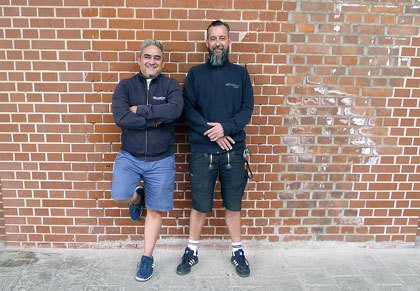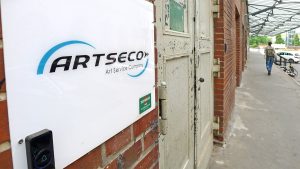
Artseco
Interview with ARTSECO: 130 metres of pallet racks
ARTSECO has turned the art market in Germany upside down with an ingenious storage system, craftsmanship and love of art. Shelves from TOPREGAL play a major role in this. For your more than 4,500 square metres of art storage in Berlin you have ordered around 130 running metres of pallet racks with two or three levels.
How did you become aware of TOPREGAL?
Miguel Adaro: We recently used five different shelving systems from different manufacturers. That didn't work in the long run because some companies said goodbye again and the individual systems were too outdated. During my Internet search for a new provider, I came across www.topregal.com landed. This is a good page. The individual shelf types are explained there in an understandable way. You can visualize what you need. And the sample offers make the calculation easier.
Why did you consciously decide against other Berlin companies?
Miguel Adaro: I was always in favour of having to support local companies. But the Berlin companies were simply too expensive. Above all, they had left us little opportunity to negotiate. We set up the shelves ourselves. They didn't want that and said that the assembly was included, which also explained the high price. On the other hand, TOPREGAL offered us really good prices and the promise of fast delivery. The Berlin companies on the other hand had waiting times of about three weeks. That was not acceptable for us.
Marc Handrich: TOPREGAL was very kind to us and gives the impression that it will continue to exist for the next few years and that if we continue to expand in the future, we can easily reorder the same system. That is particularly important to us.
You had had bad experiences with Ebay before. What did they look like?
Miguel Adaro: In the spring of 2016, our new central warehouse in Berlin-Neukölln provided us with quite a lot of space at very short notice. And the need for a lot of storage space was suddenly there. The galleries demanded more and we had to react quickly. At that time, liquidity was also still a central issue for us. So we looked at Ebay for used heavy-duty shelves.
Marc Handrich: The first time was really a good grip. But the second time it went completely wrong. It's always "bought as seen". As you sometimes know from Ebay, we had 70 percent scrap. Heavy metal scrap, which we had to dispose of first.
 Sample racks in the warehouse, loaded
Sample racks in the warehouse, loaded Managing director Miguel Adaro (left) and warehouse manager Marc Handrich
Managing director Miguel Adaro (left) and warehouse manager Marc HandrichArt has many formats, forms and materials. How does this fit together with standardised shelves?
Marc Handrich: With us, practically every shelf is individual. Simply because the art is always different. We have large and small pictures, heavy sculptures and filigree installations. So every shelf must be able to be set up and equipped individually. And that's why it's difficult for us to plan this very precisely in advance. That's why we prefer to assemble the shelves ourselves, piece by piece, just as we need them for the respective works.
Do you use the shelves as they are delivered or do you make individual modifications?
Marc Handrich: We assemble two pallet racks one behind the other to form so-called double racks, usually with a width of twice 1.10 m and then a space of 30 cm to 50 cm between them. We lay OSB boards on the entire floor. In this construction we use the lower level as picture compartments for large formats. We lay carpet in the picture compartments to allow the paintings to slide when storing and removing them. In the case of wooden crates, we leave the wooden floor, because the crates are then more mobile. And thanks to the crossbar, the weight of the boxes of different weights can be better distributed.
How is the use of the shelves billed?
Miguel Adaro: We call our concept "Inflatable Art Storage". Inflatable in the sense that the tenants really only pay for the space they actually use. In the past, entire shelf boxes were always rented out, regardless of what was stored in them. Thanks to our sophisticated warehouse management system, we can store paintings from different galleries together on one shelf. This makes things cheaper for our customers.
They have developed a new offer especially for galleries. What is it about?
Miguel Adaro: There are more and more galleries that are asking us to set up their own art warehouses. We want to develop a new business model from this. We are working out a complete storage plan and are already including the shelves and assembly in our calculations. The shelves from TOPREGAL are an integral part of our new service.
What kind of art did you store?
Miguel Adaro: It's mostly contemporary art, not old masters, because these works require a special room climate with constant temperature and humidity. We have a Warhol and we also have a Richter, but mainly contemporary works by emerging artists such as Alicja Kwade, Tony Crack or Jeppe Hein. These are all modern artists who are currently on the rise and are hyped at the fairs.
 ArtSeCo company headquarters in an old malt factory
ArtSeCo company headquarters in an old malt factory
How do you assess the current situation on the art market?
Miguel Adaro: Art has once again become a sought-after investment. Where is the return on investment as high as in the case of art? Today there is the new profession of art broker, which deals exclusively with the development of artists. And who has access to the fairs when nobody else is allowed in the halls. He talks to the galleries even before the actual vernissage has started. And he acts on behalf of top collectors. The art broker has around ten financially strong investors on hand and probably already has a wish list of them. This is a development that reminds one who has been around for a while of the time before the crash in 2007.
Is ARTSECO strongly affected by this?
Marc Handrich: We concentrate on the storage and transport of the paintings. Our personal interest and passion for art remain unaffected by the hype.
The Art Service Company GmbH (ARTSECO) was founded in 2009 after the end of the banking crisis, which also affected the art scene and art transports. Today ARTSECO is represented at art fairs worldwide. In 2012 the first art warehouse according to VDS guidelines was opened in Berlin. It was also the largest collective storage facility in conjunction with two other art transport companies in Europe. As a service ARTSECO operates an online shop with packaging material for art transports www.artseco-shop.de. Specialist training courses are regularly offered for the Berlin galleries. In addition to three locations in Berlin, ARTSECO has a branch office in Neuss.www.artseco.de
